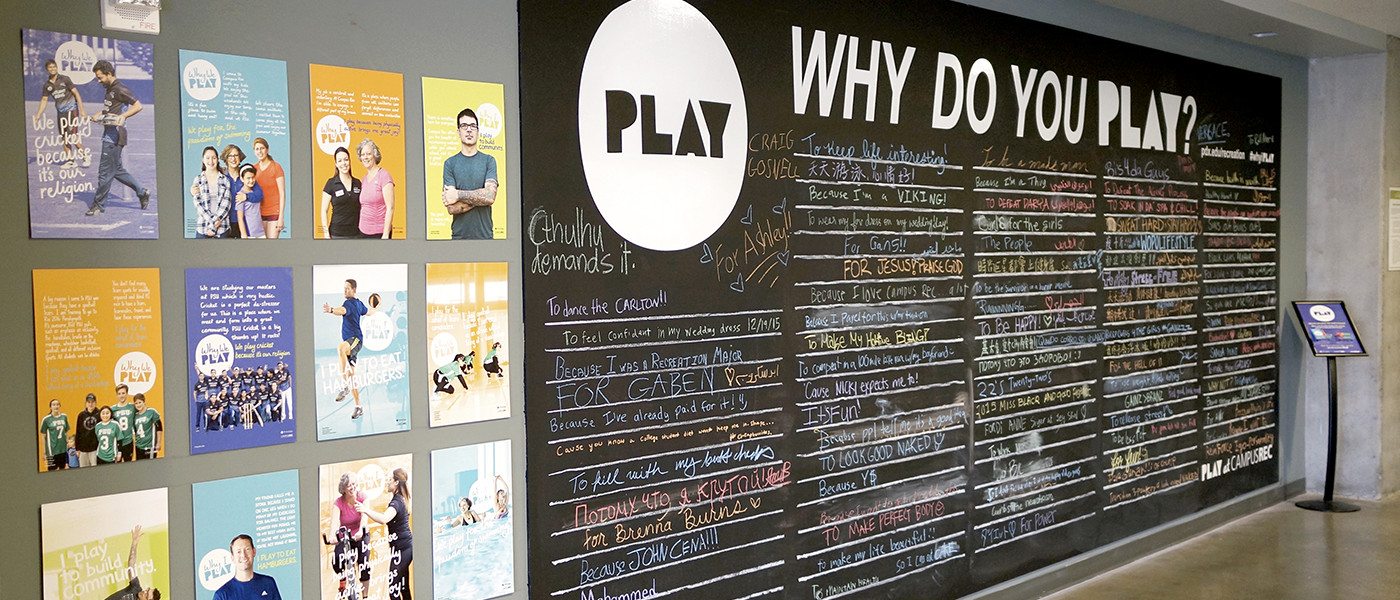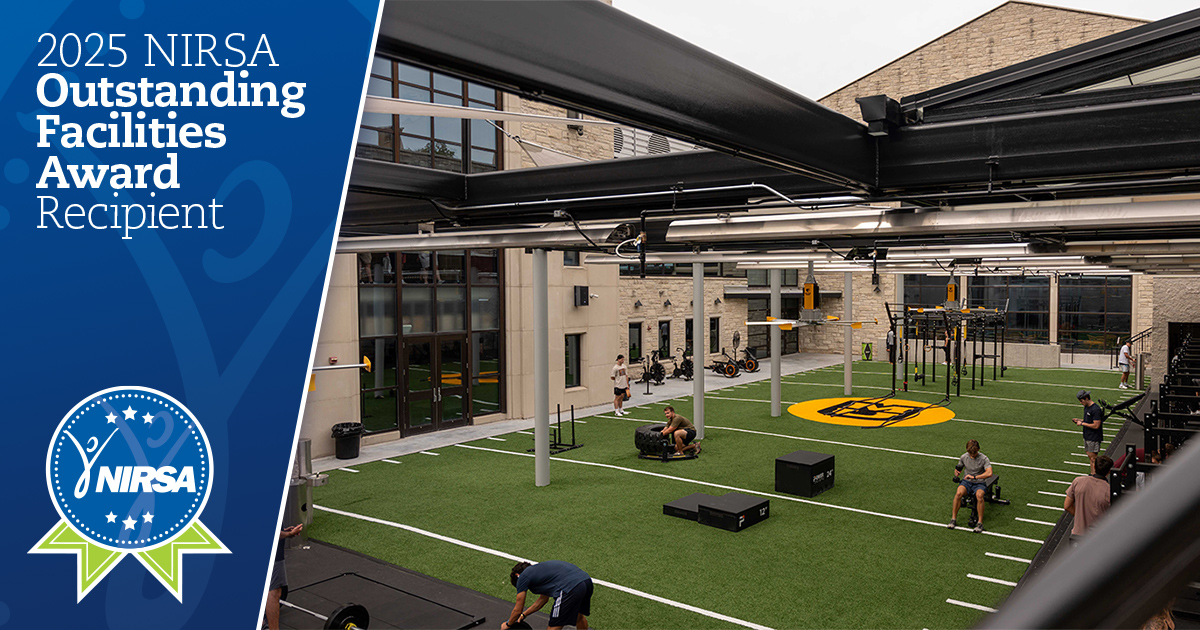Everyone who walks through the gate at Portland State Campus Rec is asked one question: “Why do you play?” And everyone is invited to pick up a piece of chalk and answer. When they do, they join hundreds of others in publicly sharing their motivations for leading a healthy and active lifestyle. Some answers include:
- To relieve stress
- To swim 11 miles in open water
- To challenge myself
- For epic Michelle Obama arms
- To eat more ice cream
- To awaken my inner child
Every day, our members share personal experiences. They share while making a promise to themselves and inspiring others.
The route to finding a brand
Two years ago we took a critical look at our brand, and this wall is one tangible outcome that concretely represents our promise to our members: “This is your place to play.”
So what exactly is a brand? The word’s meaning has come a long way since burning unique marks into livestock to denote ownership. Today, a brand is best explained with three qualifiers: perception, experience, and difference. If your team is analyzing your department’s brand, think holistically and ask yourself:
Perception
- What is your reputation?
- What do people think when they hear your name?
- What stories are people telling about you?
Experience
- How do people feel when they visit?
- Who and what are they interacting with and in what way?
- What value are you adding to their life?
- Do you meet expectations?
Difference
- What makes you unique?
- What makes you stand apart from your competitors?
- Why should people prioritize recreation over countless other commitments?
Now consider how your stakeholders would answer these questions. Students, faculty, staff, alumni, partners, and community members all have a personal and perhaps emotional connection to your department and the spaces, programs, and services it oversees. Consequently, you’ll never have complete control over your brand. But you can influence it by having a thoughtful brand strategy.
Creating a consistent brand identity
Until 2015, our department had been in a rhythm of creating a new brand strategy each year. While the concepts aligned with the department’s mission to inspire, empower, and educate—“Get Centered” emphasized the importance of balance in one’s life and “Get Into Your Shape” emphasized inclusion and body positivity—our scope, approach, and implementation were too narrow to stay engaging for more than an academic term or two.
At PSU, we were spending a lot of time, money, and resources reinventing ourselves. This also had the unintended consequence of being inconsistent in our brand identity. So we challenged ourselves to communicate more efficiently and effectively by focusing on a strategy that would yield long-term growth. Ultimately, our goal was to create a brand strategy that:
- Is relevant and focused, yet evergreen and inclusive enough to last more than one academic year
- Represents the department as a whole, as well as the breadth of programs, services, and events offered
- Appeals to the diverse wants, needs, and motivations of the Portland State community
- Promotes a successful, well-balanced, holistic higher education experience
In 2014, we produced an award-winning You Can Play video demonstrating our commitment to diversity and inclusion.
The concept of “play” is accessible, relatable, and wide-ranging. It means different things to different people. From gentle stretching and meditation to competitive intramural leagues and rec clubs, our offerings are as diverse as our members’ motivations to play. Play is easy for people to understand, and the essence of play comes naturally in just about everything our department does.
The video served as the inspiration for our new brand strategy, “Play at Campus Rec.” We magnified You Can Play by creating a conversation with our members. We tell our members they can play, and they tell us why they do.
Our department’s robust marketing team (consisting of one professional staff and eight student staff) functions as a full-service agency, including web, social, design, video, photo, and outreach. With guidance from the Marketing Pod—an advisory group of professional staff with 50+ years of combined recreation experience—the marketing team conceived, created, and launched “Play at Campus Rec” in just six months.
The PSU Play at Campus Rec timeline
March 2015
The strategy’s goals and concept were set and the marketing team brainstormed ideas for bringing the strategy to life.
April 2015
The brainstorm sessions were transformed into a formal plan that was presented to the Marketing Pod for feedback and refinement.
May 2015
The plan was adopted and the graphic designers created several Play at Campus Rec visual identity concepts. This first tactical step was critical because ordering materials for the fall academic term begins in July.
June 2015
The graphic designers presented three visual identity concepts to the Marketing Pod for feedback and refinement. A final visual identity was created and adopted.
July 2015–September 2015
Play at Campus Rec materials were created and ordered.
September 2015
Play at Campus Rec successfully launched internally at all-staff training and externally during Viking Days, the week prior to fall term when freshmen were arriving on campus.
October 2015–Present
Play at Campus Rec continues to be implemented and refined.
Thinking strategically
The strategy for our brand uses storytelling to showcase the campus rec experience. It’s designed to create a human connection, demonstrate inclusiveness, evoke emotion, and promote engagement. A diverse collection of member stories gives campus rec at PSU personality and offers relatable content inspiring members and potential members to get involved and stay involved.
These stories demonstrate how health, fitness, and recreation play an important role in a well-rounded Portland State experience. Play at Campus Rec also creates a sense of community by offering new engagement opportunities throughout campus.
Here are some examples of how the strategy was implemented:
Image #1: A Play at Campus Rec window decal says “play” in a variety of languages.
Image #2: A Play at Campus Rec step and repeat serves as a perfect backdrop for event photo booths.
Image #3: A Play at Campus Rec brochure offers an overview of the department and includes a poster. It’s printed in six languages.
Image #4: Members demonstrate their commitment to play
Image #5: Reasons why members play are found inside custom the pocket notebooks, from Campus Rec’s “Why Do You Play?” chalk wall. Responses were photographed and vectorized to retain handwriting.
How’d we do?
And the results? We set the following fiscal year 2016 metrics for success during the planning process.
- Match FY15 in total member visits
- Result: .01% increase
- Increase total program participations by 3%
- Result: 5% increase
- Increase combined home and schedule web page views by 5%
- Result: 8% increase
- Increase digital community by 12%
- Result: 28% increase
- Offer at least 12 Play-themed engagement opportunities to current/potential members
- Result: 24 offered
- Share at least 20 member stories
- Result: 20 shared
Play at Campus Rec continues today. But we know that brands are dynamic. The wants, needs, and motivations of our stakeholders are going to change with time. It’s our responsibility to be flexible and change with them.
Who we are and what we do as campus recreation professionals speaks loudly. How we communicate matters. A good brand strategy tells our story and empowers our community to participate in the process.
Photos courtesy of Portland State University
- For more information about the Portland State University Campus Rec brand strategy, please contact Marketing and Outreach Coordinator at Portland State University Erin Merz. Erin Merz.
- If you are interested in highlighting your campus or a NIRSA member’s achievements on your campus, pitch us your ideas.
Erin Merz is currently the Marketing and Outreach Coordinator at Portland State University Campus Rec. She can be reached at emerz@pdx.edu.







